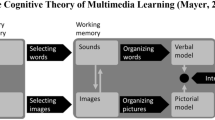Abstract
The segmenting effect states that people learn better when multimedia instructions are presented in (meaningful and coherent) learner-paced segments, rather than as continuous units. This meta-analysis contains 56 investigations including 88 pairwise comparisons and reveals a significant segmenting effect with small to medium effects for retention and transfer performance. Segmentation also reduces the overall cognitive load and increases learning time. These four effects are confirmed for a system-paced segmentation. The meta-analysis tests different explanations for the segmenting effect that concern facilitating chunking and structuring due to segmenting the multimedia instruction by the instructional designer, providing more time for processing the instruction and allowing the learners to adapt the presentation pace to their individual needs. Moderation analyses indicate that learners with high prior knowledge benefitted more from segmenting instructional material than learners with no or low prior knowledge in terms of retention performance.
Similar content being viewed by others
References
Anderson, L. W., Krathwohl, D. R., Airasian, P. W., Cruikshank, K. A., Mayer, R. E., Pintrich, P. R., et al. (2001). A taxonomy for learning, teaching, and assessing: a revision of Bloom’s taxonomy of educational objectives. New York: Longman.
Antonenko, P., Paas, F., Grabner, R., & Van Gog, T. (2010). Using electroencephalography to measure cognitive load. Educational Psychology Review, 22(4), 425–438.
Baddeley, A. D. (1992). Working memory. Science, 255(5044), 556–559.
Baddeley, A. D. (1999). Human memory. Boston: Allyn & Bacon.
Barnett, S. M., & Ceci, S. J. (2002). When and where do we apply what we learn? A taxonomy for far transfer. Psychological Bulletin, 128(4), 612–637.
Begg, C. B., & Mazumdar, M. (1994). Operating characteristics of a rank correlation test for publication bias. Biometrics, 50(4), 1088–1101.
Bloom, B. S., & Krathwohl, D. R. (1956). Taxonomy of educational objectives. The classification of educational goals, handbook I: cognitive domain. New York: Longmans Green.
Bloom, B. S., Madaus, G. F., & Hastings, J. T. (1981). Evaluation to improve learning. New York: McGraw-Hill.
Chandler, P., & Sweller, J. (1992). The split-attention effect as a factor in the design of instruction. British Journal of Educational Psychology, 62(2), 233–246.
Chen, F., Zhou, J., Wang, Y., Yu, K., Arshad, S. Z., Khawaji, A., & Conway, D. (2016). Robust multimodal cognitive load measurement. Cham: Springer International Publishing.
Clark, J. M., & Paivio, A. (1991). Dual coding theory and education. Educational Psychology Review, 3(3), 149–210.
Cook, A. E., & Wei, W. (2017). Using eye movements to study reading processes: methodological considerations. In C. A. Was, F. J. Sansoit, & B. J. Morris (Eds.), Eye tracking technology applications in educational research (pp. 27–47). Hershey: IGI Global.
Cooper, H., Hedges, L. V., & Valentine, J. C. (Eds.). (2009). The handbook of research synthesis and meta-analysis (2nd ed.). New York: Russell Sage Foundation.
DeStefano, D., & LeFevre, J.-A. (2007). Cognitive load in hypertext reading: a review. Computers in Human Behavior, 23(3), 1616–1641.
Evans, C., & Gibbons, N. J. (2007). The interactivity effect in multimedia learning. Computers & Education, 49(4), 1147–1160.
Field, A. P., & Gillett, R. (2010). How to do a meta-analysis. British Journal of Mathematical and Statistical Psychology, 63(3), 665–694.
Ginns, P. (2005). Meta-analysis of the modality effect. Learning and Instruction, 15(4), 313–331.
Ginns, P. (2006). Integrating information: a meta-analysis of the spatial contiguity and temporal contiguity effects. Learning and Instruction, 16(6), 511–525.
Grubbs, F. E. (1969). Procedures for detecting outlying observations in samples. Technometrics, 11, 1–21.
Hattie, J. (2009). Visible learning: a synthesis of over 800 meta-analyses relating to achievement. London: Routledge.
Hedges, L. V., & Olkin, I. (1985). Statistical methods for meta-analysis. Orlando: Academic.
Hedges, L. V., & Vevea, J. L. (1998). Fixed- and random-effects models in meta-analysis. Psychological Methods, 3(4), 486–504.
Hedges, L. V., Tipton, E., & Johnson, M. C. (2010). Robust variance estimation in meta-regression with dependent effect size estimates. Research Synthesis Methods, 1(1), 39–65.
Hoaglin, D. C., Mosteller, F., & Tukey, J. W. (Eds.). (1983). Understanding robust and exploratory data analysis (Vol. 3). New York: Wiley.
IBM Corp. (2017). IBM SPSS statistics for Windows (version 25.0). Armonk: IBM Corp.
Kalyuga, S. (2007). Expertise reversal effect and its implications for learner-tailored instruction. Educational Psychology Review, 19(4), 509–539.
Kalyuga, S. (2009). Knowledge elaboration: a cognitive load perspective. Learning and Instruction, 19(5), 402–410.
Kalyuga, S., & Renkl, A. (2010). Expertise reversal effect and its instructional implications: introduction to the special issue. Instructional Science, 38(3), 209–215.
Kalyuga, S., Chandler, P., & Sweller, J. (1999). Managing split-attention and redundancy in multimedia instruction. Applied Cognitive Psychology, 13(4), 351–371.
Kalyuga, S., Ayres, P., Chandler, P., & Sweller, J. (2003). The expertise reversal effect. Educational Psychologist, 38(1), 23–31.
Keehner, M., Hegarty, M., Cohen, C., Khooshabeh, P., & Montello, D. R. (2008). Spatial reasoning with external visualizations: what matters is what you see, not whether you interact. Cognitive Science, 32(7), 1099–1132.
Khooshabeh, P., & Hegarty, M. (2010). Inferring cross-sections: when internal visualizations are more important than properties of external visualizations. Human Computer Interaction, 25(2), 119–147.
Kurby, C. A., & Zacks, J. M. (2008). Segmentation in the perception and memory of events. Trends in Cognitive Sciences, 12(2), 72–79.
Lawless, K. A., & Brown, S. W. (1997). Multimedia learning environments: issues of learner control and navigation. Instructional Science, 25(2), 117–131.
Lipsey, M. W., & Wilson, D. B. (2001). Applied social research methods series; vol. 49. Practical meta-analysis. Thousand Oaks: Sage.
Mayer, R. E. (1997). Multimedia learning: are we asking the right questions? Educational Psychologist, 32(1), 1–19.
Mayer, R. E. (2014a). Cognitive theory of multimedia learning. In R. E. Mayer (Ed.), The Cambridge handbook of multimedia learning (2nd ed., pp. 43–71). Cambridge: Cambridge University Press.
Mayer, R. E. (2014b). Introduction to multimedia learning. In R. E. Mayer (Ed.), The Cambridge handbook of multimedia learning (2nd ed., pp. 1–24). Cambridge: Cambridge University Press.
Mayer, R. E., & Pilegard, C. (2014). Principles for managing essential processing in multimedia learning: segmenting, pre-training, and modality principles. In R. E. Mayer (Ed.), The Cambridge handbook of multimedia learning (2nd ed., pp. 316–344). Cambridge: Cambridge University Press.
Mayer, R. E., Moreno, R., Boire, M., & Vagge, S. (1999). Maximizing constructivist learning from multimedia communications by minimizing cognitive load. Journal of Educational Psychology, 91(4), 638–643.
Mura, K., Petersen, N., Huff, M., & Ghose, T. (2013). IBES: a tool for creating instructions based on event segmentation. Frontiers in Psychology, 4(994). https://doi.org/10.3389/fpsyg.2013.00994
Oksa, A., Kalyuga, S., & Chandler, P. (2010). Expertise reversal effect in using explanatory notes for readers of Shakespearean text. Instructional Science, 38(3), 217–236.
Paas, F. (1992). Training strategies for attaining transfer of problem solving skill in statistics: a cognitive-load approach. Journal of Educational Psychology, 84(4), 429–434.
Paivio, A. (1986). Mental representations: a dual coding approach. New York: Oxford University Press.
Rustenbach, S. J. (2003). Metaanalyse: Eine anwendungsorientierte Einführung. Bern: Huber.
Scharinger, C., Kammerer, Y., & Gerjets, P. (2015). Pupil dilation and EEG alpha frequency band power reveal load on executive functions for link-selection processes during text reading. PLoS One, 10(6), e0130608.
Scheiter, K., & Gerjets, P. (2007). Learner control in hypermedia environments. Educational Psychology Review, 19(3), 285–307.
Schneider, S., Beege, M., Nebel, S., & Rey, G. D. (2018a). A meta-analysis of how signaling affects learning with media. Educational Research Review, 23, 1–24.
Schneider, S., Wirzberger, M., & Rey, G. D. (2018b). The moderating role of arousal on the seductive detail effect. Applied Cognitive Psychology. https://doi.org/10.1002/acp.3473.
Schnotz, W., & Kürschner, C. (2007). A reconsideration of cognitive load theory. Educational Psychology Review, 19(4), 469–508.
Schnotz, W., & Lowe, R. (2008). A unified view of learning from animated and static graphics. In R. Lowe & W. Schnotz (Eds.), Learning with animations: research implications for design (pp. 304–356). New York: Cambridge University Press.
Skuballa, I. T., Schwonke, R., & Renkl, A. (2012). Learning from narrated animations with different support procedures: working memory capacity matters. Applied Cognitive Psychology, 26(6), 840–847.
Spanjers, I. A. E., Van Gog, T., & Van Merrienboer, J. J. G. (2010). A theoretical analysis of how segmentation of dynamic visualizations optimizes students' learning. Educational Psychology Review, 22(4), 411–423.
Sterne, J. A., Becker, B. J., & Egger, M. (2005). The funnel plot. In H. R. Rothstein, A. J. Sutton, & M. Borenstein (Eds.), Publication bias in meta-analysis: prevention, assessment and adjustments (pp. 75–98). West Sussex: Wiley.
Sweller, J. (1988). Cognitive load during problem solving: effects on learning. Cognitive Science, 12(2), 257–285.
Sweller, J., Ayres, P., & Kalyuga, S. (2011). Cognitive load theory. New York: Springer.
Tobias, S. (1976). Achievement treatment interactions. Review of Educational Research, 46(1), 61–74.
Vygotski, L. S. (1963). Learning and mental development at school age. In B. Simon & J. Simon (Eds.), Educational psychology in the U.S.S.R (pp. 21–34). London: Routledge & Kegan Paul.
Wickens, C. D., Hollands, J. G., Banbury, S., & Parasuraman, R. (2013). Engineering psychology and human performance (4th ed.). Boston: Pearson Education.
Wilson, D. B. (2001). Practical meta-analysis effect size calculator. Retrieved from http://www.campbellcollaboration.org/escalc/html/EffectSizeCalculator-SMD1.php. Accessed 07/06/2018
Wilson, D. B. (2010). Meta-analysis macros for SAS, SPSS, and Stata. Retrieved from http://mason.gmu.edu/~dwilsonb/ma.html
Wirzberger, M., Herms, R., Esmaeili Bijarsari, S., Eibl, M., & Rey, G. D. (2018). Schema-related cognitive load influences performance, speech, and physiology in a dual-task setting: a continuous multi-measure approach. Cognitive Research: Principles and Implications, 3, 46. https://rdcu.be/bcXiM.
Zacks, J. M., Speer, N. K., Swallow, K. M., Braver, T. S., & Reynolds, J. R. (2007). Event perception: a mind–brain perspective. Psychological Bulletin, 133(2), 273–293.
Author information
Authors and Affiliations
Corresponding author
Additional information
Publisher’s Note
Springer Nature remains neutral with regard to jurisdictional claims in published maps and institutional affiliations.
Rights and permissions
About this article
Cite this article
Rey, G.D., Beege, M., Nebel, S. et al. A Meta-analysis of the Segmenting Effect. Educ Psychol Rev 31, 389–419 (2019). https://doi.org/10.1007/s10648-018-9456-4
Published:
Issue Date:
DOI: https://doi.org/10.1007/s10648-018-9456-4




